R.J. Stowell's Blog: rjsomeone, page 38
October 8, 2019
Elton John/Bernie Taupin - The Early Years
 Although the pudgy kid known as Reg Dwight had always considered a music career, he'd spent the 60s as an un-credited studio musician for artists like The Hollies, until, in 1966, he answered an ad from Liberty Records and was given lyrics by a 17-year-old Bernie Taupin. Reg was so taken by Bernie's words that he wrote songs for each, though he wouldn't meet Taupin for six months. Before long, they found their songs covered by everyone from Aretha Franklin to Three Dog Night. And although that success got the newly-named Elton John a record deal, it didn't produce immediate results: it was two years before he scored his own hit with 1970's "Your Song." A tremendously influential series of live performances at L.A.'s Troubadour proved that John - who'd been a huge Jerry Lee Lewis fan - could rock as hard as anyone, and before long his solo career was taking off both on stage and in the studio.
Although the pudgy kid known as Reg Dwight had always considered a music career, he'd spent the 60s as an un-credited studio musician for artists like The Hollies, until, in 1966, he answered an ad from Liberty Records and was given lyrics by a 17-year-old Bernie Taupin. Reg was so taken by Bernie's words that he wrote songs for each, though he wouldn't meet Taupin for six months. Before long, they found their songs covered by everyone from Aretha Franklin to Three Dog Night. And although that success got the newly-named Elton John a record deal, it didn't produce immediate results: it was two years before he scored his own hit with 1970's "Your Song." A tremendously influential series of live performances at L.A.'s Troubadour proved that John - who'd been a huge Jerry Lee Lewis fan - could rock as hard as anyone, and before long his solo career was taking off both on stage and in the studio.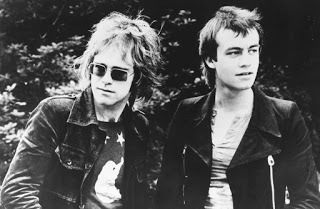 Bernie Taupin was born in 1950 at Flatters Farmhouse in the southern part of Lincolnshire England. He was not a diligent student but showed an early flair for writing. His maternal grandfather was a classics teacher and graduate of the University of Cambridge, his mother studied French Literature, and his father was a farmer. They taught him an appreciation for nature and for literature and narrative poetry, all of which influenced his lyrics. At age 15, he left school and started work as a trainee in the print room of the local newspaper, The Lincolnshire Standard with aspirations to be a journalist. He soon left and spent the rest of his teenage years hanging out with friends, hitchhiking the country roads to attend youth club dances in the surrounding villages, playing snooker in the Aston Arms Pub in Market Rasen, and drinking. He'd worked at several part-time jobs when, at age 16, he answered the advertisement that eventually led to his collaboration with Elton John.
Bernie Taupin was born in 1950 at Flatters Farmhouse in the southern part of Lincolnshire England. He was not a diligent student but showed an early flair for writing. His maternal grandfather was a classics teacher and graduate of the University of Cambridge, his mother studied French Literature, and his father was a farmer. They taught him an appreciation for nature and for literature and narrative poetry, all of which influenced his lyrics. At age 15, he left school and started work as a trainee in the print room of the local newspaper, The Lincolnshire Standard with aspirations to be a journalist. He soon left and spent the rest of his teenage years hanging out with friends, hitchhiking the country roads to attend youth club dances in the surrounding villages, playing snooker in the Aston Arms Pub in Market Rasen, and drinking. He'd worked at several part-time jobs when, at age 16, he answered the advertisement that eventually led to his collaboration with Elton John.Bernie’s unique blend of influences gave his early lyrics a nostalgic romanticism that fit perfectly with the hippie sensibilities of the late 1960s and early 1970s. He sometimes wrote about specific places in his home town of Lincolnshire. For example, Grimsby or ‘Caribou’ was a tongue-in-cheek tribute to a nearby port town often visited by Taupin and his friends. More famously,"Saturday’s Alright For Fighting" was inspired by Taupin’s experiences in the dance halls and pubs of his youth. More often he wrote in more general autobiographical terms, as in his reference to hitching rides home in "Country Comfort." These autobiographical references to his rural upbringing continued after his departure for London and a life in show business, with songs such as "Honky Cat," "Tell Me When The Whistle Blows" and "Goodbye Yellow Brick Road," in which he thinks about "going back to my plough."Together, Bernie and Elton found a niche with what might be assumed American folk, somewhere along the lines of Woody Guthrie or Ramblin’ Jack Elliot, their music that storied, that romantic. For Tumbleweed Connection, Elton's forth LP, the pair crafted an LP of ten songs with a theme they couldn't have known much about, except through books and Taupin's imagination: the American Civil War and subsequent land expansion out west. Though falling short of a masterpiece, the duo found a way to express their fantasy in an unusually conceptual album. "Ballad of a Well-Known Gun" opens the album, addressing the concerns of a man arrested for unspecified crimes, yet showing deep remorse when he's thrown in prison by the Pinkertons (the forerunner of modern-day detective agencies), as well as losing all his ill-gotten gains. The dusty verisimilitude seeps out of "Song of Your Father" and "Talking Old Soldiers;" the former about a blind man who confronts a "friend" who owes him money by brandishing a rifle. The accused relents, but only to bide time to gain the advantage over the blind gun-toter; the result is two men "lying dead as nails on an East Virginia farm." That's storytelling, and Taupin is the kingpin of rock storytelling. The latter track deals with an aged Civil War vet who stumbles upon a fellow warrior. Taupin's lyrics are superb, and the idea of two former soldiers drowning their sorrows over everyone's lack of understanding as to what they went through, can be a hard topic to cover in a three minute pop song. However, with only Elton's rising and falling piano chords the only accompaniment, it works splendidly.
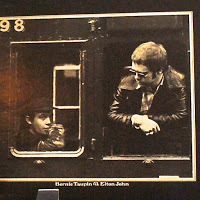 Of course, you have two wonderful love songs, "Come Down in Time", featuring the orchestration of Paul Buckmaster. Though the theme is esoteric, it lends an air of mystery and charm. "Love Song", a song written by Lesley Duncan, is a stark tune played on acoustic guitar with deft toe-tapping noticeable."Where to Now, St. Peter?" is a swirling blues rocker about a man's journey into death, while questioning his fate and faith. Again, Taupin's esoteric themes make this song less than cut-and-dried, and all the more intriguing. One of the best tracks is "Burn Down the Mission", an old concert favorite. The war between the haves and have-nots is eloquently stated, with Elton's rising and falling piano competing with Buckmaster's strings. "My Father's Gun" is the tale of the Johnny Reb who buries his father (killed by a Northern soldier), and vows to avenge his death by finding the nearest regiment. "Country Comfort" is hokey like a hoedown and the bouncy "Amoreena" is a lot of fun, strongly evoking the Southern coquette pictured so vividly in the listener's mind. Tumbleweed Connection is an album reminiscent of another Brit take on American life 100 years ago, The Notting-Hillbillies. Tumbleweed Connection is Elton country-bluegrass, and it works on just the right level.
Of course, you have two wonderful love songs, "Come Down in Time", featuring the orchestration of Paul Buckmaster. Though the theme is esoteric, it lends an air of mystery and charm. "Love Song", a song written by Lesley Duncan, is a stark tune played on acoustic guitar with deft toe-tapping noticeable."Where to Now, St. Peter?" is a swirling blues rocker about a man's journey into death, while questioning his fate and faith. Again, Taupin's esoteric themes make this song less than cut-and-dried, and all the more intriguing. One of the best tracks is "Burn Down the Mission", an old concert favorite. The war between the haves and have-nots is eloquently stated, with Elton's rising and falling piano competing with Buckmaster's strings. "My Father's Gun" is the tale of the Johnny Reb who buries his father (killed by a Northern soldier), and vows to avenge his death by finding the nearest regiment. "Country Comfort" is hokey like a hoedown and the bouncy "Amoreena" is a lot of fun, strongly evoking the Southern coquette pictured so vividly in the listener's mind. Tumbleweed Connection is an album reminiscent of another Brit take on American life 100 years ago, The Notting-Hillbillies. Tumbleweed Connection is Elton country-bluegrass, and it works on just the right level.
Published on October 08, 2019 04:30
October 7, 2019
Elton's Grand Entrance...
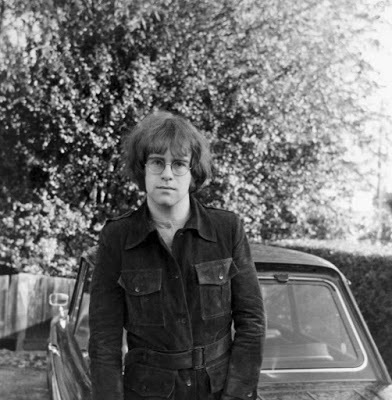 As a young boy, Reg Dwight spent five years at the Royal Academy of Music, his natural talent leading him to an audition at which everyone was awestruck. But Elvis and Buddy Holly would change the direction he'd take as a teenager, and then, in 1968, as part of a band called Bluesology, Reg answered an advertisement that read, "Liberty Wants Talent." In the audition for Liberty, he was asked his name and, chose Elton, just because he liked it, and John because of John Lennon. From that, he was handed a stack of hand-scribbled poems by Bernie Taupin and asked that he write the music for them, the most famous among them, "The Border Song," truly classic Elton. And fifty years ago, Elton's first LP, Empty Sky, was released in the U.K., an album that would not be released in America until 1975. Elton's debut, therefore, was his sophomore effort, Elton John, which had three hits in "Take Me To the Pilot," "The Border Song," and most famously, indeed one of the most famous songs of all time, "Your Song," which remains as popular today, if not more so than 50 years ago; the song streamed more than 100,000,000 times on Spotify alone.
As a young boy, Reg Dwight spent five years at the Royal Academy of Music, his natural talent leading him to an audition at which everyone was awestruck. But Elvis and Buddy Holly would change the direction he'd take as a teenager, and then, in 1968, as part of a band called Bluesology, Reg answered an advertisement that read, "Liberty Wants Talent." In the audition for Liberty, he was asked his name and, chose Elton, just because he liked it, and John because of John Lennon. From that, he was handed a stack of hand-scribbled poems by Bernie Taupin and asked that he write the music for them, the most famous among them, "The Border Song," truly classic Elton. And fifty years ago, Elton's first LP, Empty Sky, was released in the U.K., an album that would not be released in America until 1975. Elton's debut, therefore, was his sophomore effort, Elton John, which had three hits in "Take Me To the Pilot," "The Border Song," and most famously, indeed one of the most famous songs of all time, "Your Song," which remains as popular today, if not more so than 50 years ago; the song streamed more than 100,000,000 times on Spotify alone.In our survey of all things 50 years ago, we're not quite at the Elton John stage; just a side note that this was how it all began.
Published on October 07, 2019 05:11
October 6, 2019
Looking Back on Ginger Baker's Finest Moments
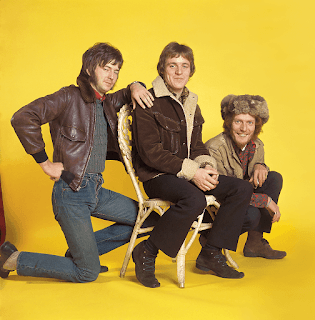 Remembering Ginger Baker, who died yesterday at the age of 80.
Remembering Ginger Baker, who died yesterday at the age of 80.In November 1967, in a musically perfect year that couldn't get any better, Cream released Disraeli Gears. Fresh Cream had debuted arrived in late 1966 and while it was a breakthrough album in many ways (the seeds of heavy rock can be found here) the LP was little more than their stage act committed to vinyl. Six months later, psychedelia was in full swing. Eric Clapton's and Jack Bruce's guitars, along with Ginger's drums, were given a makeover by Dutch art collective Simon and Marjike, otherwise known as The Fool, who were soon to become famous for their work with the Beatles. It was the new, dandified Cream that came to New York in April 1967 to record their second album at Atlantic Studios. Although Cream's manager Robert Stigwood (yes, of Stayin' Alive/disco fame) was credited as producer on Fresh Cream his involvement was minimal and almost certainly more administrative than musical.
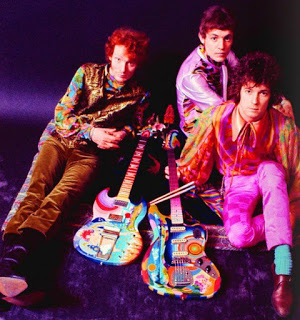 This time around Cream planned to get serious in the studio, Beatles-style. Atlantic Studios were already using 8-track recording technology, something unknown in the UK at that time. With legendary engineer Tom Dowd at the controls, they brought in a young producer named Felix Pappalardi. Pappalardi was a talented musician/arranger and Atlantic boss Ahmet Ertegun felt he would work well with the British band. The first track recorded was the blues standard "Lawdy Mama" with Ertegun as producer. It didn’t turn out quite as planned, so Felix Pappalardi took over for the rest of the two recording sessions running only six days in April/May 1967.Pappalardi took the tapes of "Lawdy Mama" and, with new lyrics by his wife Gail Collins, asked Clapton to overdub a revised vocal and some Albert King-like guitar lines. The result was the album's powerful opening track, "Strange Brew," the LP's most obvious nod to psychedelia. "World Of Pain" is the second Felix Pappalardi/Gail Collins co-composition and was written in tribute to a tree growing in their Greenwich Village yard. While relatively light on substance, the track is rescued by Eric's backtrack guitar and some massive drumming from Ginger (which, of course, is redundant). Likewise, the pop-psych of "Dance the Night Away" would be a throwaway track in the hands of any other band but the sheer musicianship of Cream saves the day. For any other band, these two tracks would have been fluff; for Cream, that fluff turns into classic blues that keep the LP an AM10.
This time around Cream planned to get serious in the studio, Beatles-style. Atlantic Studios were already using 8-track recording technology, something unknown in the UK at that time. With legendary engineer Tom Dowd at the controls, they brought in a young producer named Felix Pappalardi. Pappalardi was a talented musician/arranger and Atlantic boss Ahmet Ertegun felt he would work well with the British band. The first track recorded was the blues standard "Lawdy Mama" with Ertegun as producer. It didn’t turn out quite as planned, so Felix Pappalardi took over for the rest of the two recording sessions running only six days in April/May 1967.Pappalardi took the tapes of "Lawdy Mama" and, with new lyrics by his wife Gail Collins, asked Clapton to overdub a revised vocal and some Albert King-like guitar lines. The result was the album's powerful opening track, "Strange Brew," the LP's most obvious nod to psychedelia. "World Of Pain" is the second Felix Pappalardi/Gail Collins co-composition and was written in tribute to a tree growing in their Greenwich Village yard. While relatively light on substance, the track is rescued by Eric's backtrack guitar and some massive drumming from Ginger (which, of course, is redundant). Likewise, the pop-psych of "Dance the Night Away" would be a throwaway track in the hands of any other band but the sheer musicianship of Cream saves the day. For any other band, these two tracks would have been fluff; for Cream, that fluff turns into classic blues that keep the LP an AM10.
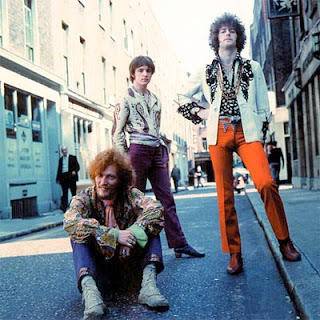 "Blue Condition" is Ginger Baker's only writing credit on the album and his only vocal. Like Ringo, Ginger was allowed a song or two on every Cream outing, no matter how unusualthe results. Interestingly, the Deluxe Edition Disraeli Gears features an alternate take with Eric on vocals that works so much better (what would that have done, an AM11?). For every fault side one may have, all is forgiven with Ginger’s impeccable drumming and syncopation, Bruce's melodic bass and Eric's incredible slow-hand blues. With music by Eric Clapton and lyrics by Australian graphic artist Martin Sharp, side two kicks off with "Tales Of Brave Ulysses," the third absolute classic track on the album. The story goes that Sharp wrote the lyrics as a poem in Greece en route from Australia to Britain. In London, he met Clapton at the Speakeasy and gave him the poem written on a napkin. Eric quickly penned the score and the psychedelic wah-wah extravaganza that is "Tales of Brave Ulysses" was born.
"Blue Condition" is Ginger Baker's only writing credit on the album and his only vocal. Like Ringo, Ginger was allowed a song or two on every Cream outing, no matter how unusualthe results. Interestingly, the Deluxe Edition Disraeli Gears features an alternate take with Eric on vocals that works so much better (what would that have done, an AM11?). For every fault side one may have, all is forgiven with Ginger’s impeccable drumming and syncopation, Bruce's melodic bass and Eric's incredible slow-hand blues. With music by Eric Clapton and lyrics by Australian graphic artist Martin Sharp, side two kicks off with "Tales Of Brave Ulysses," the third absolute classic track on the album. The story goes that Sharp wrote the lyrics as a poem in Greece en route from Australia to Britain. In London, he met Clapton at the Speakeasy and gave him the poem written on a napkin. Eric quickly penned the score and the psychedelic wah-wah extravaganza that is "Tales of Brave Ulysses" was born.
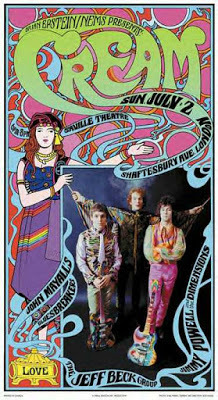 "SWLABR" is next up and the hits just keep on coming. This Bruce/Brown full-tilt rocker with a killer double-tracked solo from Eric appeared as the B-side of the "Sunshine of Your Love" single. "SWLABR" is an acronym for "She Was Like a Bearded Rainbow."The slow minor key psychedelic drone of "We're Going Wrong" is the only Jack Bruce track on the album written without Pete Brown. The unhurried pace of the song is belied by Ginger's rolling drum pattern which is relentless throughout and when performed live, played on timpani with mallets. Despite the hits inherent in "Sunshine," "Strange Brew" and "Tales," "We're Going Wrong" is the LP's finest moment and the most emotionally charged of all Cream songs in concert. "Outside Woman Blues" is an Arthur Reynolds song dating back to 1929. It's unrecognizable here, however, as it receives a bluesy heavy rock makeover in the same way that Robert Johnson's "Crossroads" would the following year. Another classic track. "Take It Back" is a Bruce penned anti-Vietnam War song, the lyrics of which were inspired by media images of American students burning their draft cards. It features no guitar solos to speak of, just an ensemble backing with harmonica and plenty of background party noises. The LPs diversity shines here. Where is doesn't is with the LP's tag-on "Mother's Lament," a vaudevillian, drunken singalong that truly serves no more purpose than a song like "Her Majesty" on Abbey Road.Despite its charmingly home-made feel Disraeli Gears has one of the most distinctive and eye-catching album covers of any era which captures the essence of 1967 more than any other record sleeve bar Sgt. Pepper, and equally iconic. Martin Sharp's contribution to both "Tales" and the iconic cover make him as essential to Disraeli Gears as Billy Preston was to Let It Be. Cream's Disraeli Gears is a definite must-have classic, an iconic musical amalgam of the 60s.
"SWLABR" is next up and the hits just keep on coming. This Bruce/Brown full-tilt rocker with a killer double-tracked solo from Eric appeared as the B-side of the "Sunshine of Your Love" single. "SWLABR" is an acronym for "She Was Like a Bearded Rainbow."The slow minor key psychedelic drone of "We're Going Wrong" is the only Jack Bruce track on the album written without Pete Brown. The unhurried pace of the song is belied by Ginger's rolling drum pattern which is relentless throughout and when performed live, played on timpani with mallets. Despite the hits inherent in "Sunshine," "Strange Brew" and "Tales," "We're Going Wrong" is the LP's finest moment and the most emotionally charged of all Cream songs in concert. "Outside Woman Blues" is an Arthur Reynolds song dating back to 1929. It's unrecognizable here, however, as it receives a bluesy heavy rock makeover in the same way that Robert Johnson's "Crossroads" would the following year. Another classic track. "Take It Back" is a Bruce penned anti-Vietnam War song, the lyrics of which were inspired by media images of American students burning their draft cards. It features no guitar solos to speak of, just an ensemble backing with harmonica and plenty of background party noises. The LPs diversity shines here. Where is doesn't is with the LP's tag-on "Mother's Lament," a vaudevillian, drunken singalong that truly serves no more purpose than a song like "Her Majesty" on Abbey Road.Despite its charmingly home-made feel Disraeli Gears has one of the most distinctive and eye-catching album covers of any era which captures the essence of 1967 more than any other record sleeve bar Sgt. Pepper, and equally iconic. Martin Sharp's contribution to both "Tales" and the iconic cover make him as essential to Disraeli Gears as Billy Preston was to Let It Be. Cream's Disraeli Gears is a definite must-have classic, an iconic musical amalgam of the 60s.
Published on October 06, 2019 16:06
October 5, 2019
Waits and Me - Ramblings From 3am
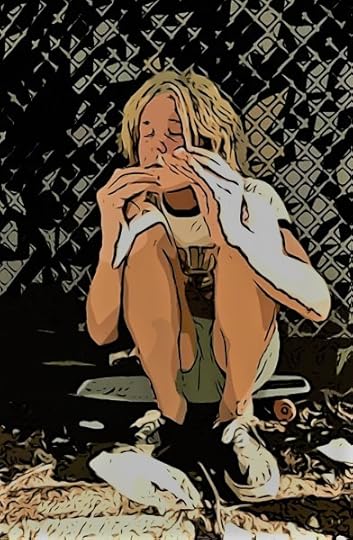 When I look at the gritty persona and the Bukowski stylings, I can't associate much with Tom Waits. His is a life I am both jealous and afraid of. But when he talks about the Sav-on and the heart of Saturday night, I find a lot of me there. It's the storytelling where we mesh. Indeed, Waits and I have told so many different stories that it's difficult to distinguish fact from fiction.
When I look at the gritty persona and the Bukowski stylings, I can't associate much with Tom Waits. His is a life I am both jealous and afraid of. But when he talks about the Sav-on and the heart of Saturday night, I find a lot of me there. It's the storytelling where we mesh. Indeed, Waits and I have told so many different stories that it's difficult to distinguish fact from fiction.Waits spent most of his youth in Whittier, California with his parents and two sisters. His father played Spanish guitar, his mother always singing, the house filled with music. Waits then learned piano from his neighbor.
There is so much "Jay" in that (of course, a shameless plug for Jay and the Americans). My neighbor in 7th grade was a woman who taught piano and worked in a piano bar on Roscoe Blvd. in the Valley. She'd written a hit for Frank Sinatra, but still she worked in a piano bar with a tip jar until 2:00 in the morning. She gave me free piano lessons and a key to her apartment, but I was as lazy as the day was long and her instruction never got me past Shaum's red book.
Like most of the kids, Waits had a gang of neighbor buddies and they were doing standard kid stuff - "Hanging around in the Sav-On parking lots and buying baseball cards" (from "Kentucky Avenue"). During one of his concerts in 1981, an incredible performance at McCabe's, Waits mentioned those little meaningful things from his childhood like having a tree fort, his first cigarette when he was seven, and being the neighborhood mechanic, repairing everyone's bicycles. When he was ten, his parents were divorced, and he moved with his mother and sisters to Chula Vista. He was fascinated by neighboring National City, a grimy suburb of San Diego, and here is where Tom was indoctrinated into a whole new world - he started hanging out with "pool hustlers, vinyl-booted go-go dancers, traveling salesmen and assorted gangsters." He was spending whole days watching movies at the Globe, a local movie theater, or playing on an old piano (which he got from a neighbor) in his garage. Tom acquired his appreciation for the blues while he was attending an all-black junior high school. There he became a huge fan of Ray Charles.
So that's some romantic shit right there; I was too afraid of life for that.
When he was fourteen, he worked at Napoleone's Pizza parlor. By then, music was the only thing that was important to Tom. He dropped out of school and began writing songs in earnest. Later he had a series of dead-end jobs like janitor, cook, dishwasher, cabdriver, fireman, delivery guy. Pretty much like all of us, but few of us have the opportunity to turn the mundane into genius.
You know that kid who everyone liked and the teacher thought was going to be a big star? The handsome guy who won the talent show and was popular with the ladies? Yeah, that wasn't him. Tom Waits said: "If I exorcise my demons, my angels may leave too" (from "Please Call Me, Baby"). When I wrote the character Maxwell Tennial (Max Ten), a young Waits was what I had in mind; a philosopher rogue who was popular despite himself – Tennial/Waits was who I wanted to be, my Tyler Durden, quoting Rimbaud and Hemingway. I didn't even come close, of course, just close to people like him – I was a disciple not a guru, but Waits, too, had the disciple in him, though his gurus were Bacon and Bukowski (mine, instead, was Walt Disney, and the Hari's on Hollywood Blvd - again, read Jay and the Americans).
That in mind, "Champaign for my real friends,/ Real pain for my sham friends" was actually from Francis Bacon, and from Rainer Maria Rilke, who rejected psychotherapy with the words, came the words, "If my devils are to leave me, I am afraid my angels will take flight as well." It's the sign of a good storyteller, steal from others without anyone even knowing. Thanks, Tom. Thanks, Max.
Published on October 05, 2019 23:39
Update - Jay and the Google Matrix
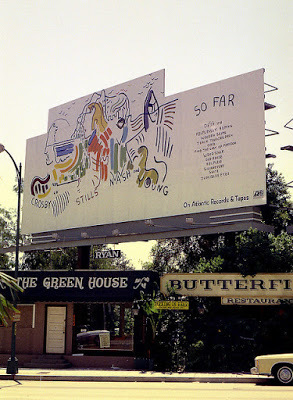 The Google Matrix, or algorithm, is fascinating (algorithms in general are fascinating). But for AM, Google's search engine sparked our interest in just how it all works. When AM first started, we'd get 15 to 20 hits per day. The reality was, we were thrilled. A hundred or so people were reading the blog on a weekly basis! Determined to make a success of it, and doing it by the seat of our pants, we vowed to post an article per day. Gun shy when it comes to Facebook and the social media applications, building an audience was nothing more than perseverance. Today, rather than 100 readers per week, we average 1000 readers per day and are approaching the half-million mark overall. Thanks to all of you who have helped to up the matrix. Now, here's the shameless plug: R.J. Stowell's Jay and the Americans is this writer's first published novel. It's available on Amazon worldwide, on CreateSpace and on Kindle by clicking on the links below or in the sidebar. If you enjoy the website, you'll love the novel. Sales for the novel are used to fund our next big projects, a novel about Woodstock, Miles From Nowhere, and its follow-up Calif.
The Google Matrix, or algorithm, is fascinating (algorithms in general are fascinating). But for AM, Google's search engine sparked our interest in just how it all works. When AM first started, we'd get 15 to 20 hits per day. The reality was, we were thrilled. A hundred or so people were reading the blog on a weekly basis! Determined to make a success of it, and doing it by the seat of our pants, we vowed to post an article per day. Gun shy when it comes to Facebook and the social media applications, building an audience was nothing more than perseverance. Today, rather than 100 readers per week, we average 1000 readers per day and are approaching the half-million mark overall. Thanks to all of you who have helped to up the matrix. Now, here's the shameless plug: R.J. Stowell's Jay and the Americans is this writer's first published novel. It's available on Amazon worldwide, on CreateSpace and on Kindle by clicking on the links below or in the sidebar. If you enjoy the website, you'll love the novel. Sales for the novel are used to fund our next big projects, a novel about Woodstock, Miles From Nowhere, and its follow-up Calif. Abby Hoffman's 1960s political treatise was called Steal This Book. I hope that soon indeed there will be enough copies of Jay and the Americans out there to steal; in the meantime, PLEASE BUY THE BOOK; help to fund AM. In the meantime, here's a Magical Mystery Tour teaser from the novel:
Between Doheny and Laurel Canyon, the Sunset Strip was littered with giant billboards, much of it my father’s work. You'd find him above it all, like Michelangelo in modern times. He painted the billboard for Tommy by the Who and Disraeli Gears down by The Classic Cat. He did Led Zeppelin IV and Aja and 461 Ocean Blvd.
"Can I come up?" He looked at me from the scaffolding above.
He was working on So Far by Crosby, Stills, Nash and Young. Joni Mitchell did the painting for this anthology of hits, but my father brought it to life, made it big and bold and out there for the world to see. It stood above the Chateau Marmont on the north side of the Strip. I think he captured Neil a bit better than Joni did; something about Neil, that crazy look of his. "Can I come up?"
"You're not allowed to come up."
"But I need to come up."
"Then come up." It was the kind of conversation one had with my father. I climbed the ladder to the top of the billboard, Los Angeles spread out beneath us on one of those few clear days, the days you wait for, the sun warm, the air cool and crisp. I liked being at the top of the city, at the top of Mulholland, or sneaking up by the Hollywood sign. There were times growing up when we'd drive up Blue Jay Way and park in front of George Harrison's house, even though he didn't live there anymore. Sunset Plaza, stay to your left, drive up and up and up. There was no street sign because everyone stole it; they just painted Blue Jay Way on the curb. And we'd sit on one of those big flat boulders that hang like a balcony over the lights and the geometry and smoke weed. That was my L.A. growing up.
"Mom died," I said, a little out of breath.
He did something funny with his brush. It wasn't what he was supposed to do. He stood a second or more, and then he just started painting again as I watched. He looked down at his samples, at what he was supposed to do. There was a geometry to it. The samples were cordoned off into little squares and he had only to paint each square and connect them together like one of those sliding block puzzles; just a trick to make it big.
So Far. How far we'd come to get just so far. I sat and looked out over the city on that clear, clear day. There was the Troubadour. There was Paramount and MGM.
We went to Carney's for a chili dog and sat in the old train car as if we were traveling cross county. He said, "Did she say anything?" What he meant was, "Did she say anything about me?"
"She didn’t say anything.” He kind of winced or winked a little, and I think I caught a glimmer in his eye of the girl who'd turned him down, the girl who ultimately gave up everything. I saw that something in his eye, that moment in time when she’d say yes and it meant something. Suddenly obliterated was every other moment when she said yesand it didn't matter, or no and it did. As if it didn't matter that she'd taken him to court for child support, that she took me away in the middle of the night, that she ran into the arms of another man. Or that he’d done the same with the woman two doors down. Didn't matter. It might have been nothing, just a gleam in his eye.
 CreateSpace - Amazon - Amazon UK
CreateSpace - Amazon - Amazon UKAmazon France - Amazon Russia
Published on October 05, 2019 23:26
Foster and Kleiser
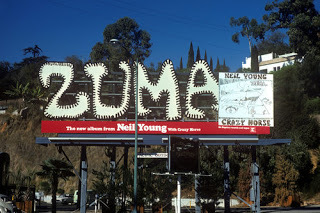 In the ten years following the release of Rubber Soul, rock music evolved from the Beatlescentric Brit invasion and the folk-rock of Laurel Canyon to an unprecedented diversity, along the way leaving us L.A. Woman, Blue, Deja Vu, Sgt. Pepper and Pet Sounds, American Beauty and Dark Side. 1976 gave us the first post-Gabriel Genesis LP, the jazz-infused Royal Scam by Steely Dan (not to mention Joni's Hejira), the blue-eyed soul of Bowie's Station to Station and the Eagles' Hotel California. Rock music was all over the map.
In the ten years following the release of Rubber Soul, rock music evolved from the Beatlescentric Brit invasion and the folk-rock of Laurel Canyon to an unprecedented diversity, along the way leaving us L.A. Woman, Blue, Deja Vu, Sgt. Pepper and Pet Sounds, American Beauty and Dark Side. 1976 gave us the first post-Gabriel Genesis LP, the jazz-infused Royal Scam by Steely Dan (not to mention Joni's Hejira), the blue-eyed soul of Bowie's Station to Station and the Eagles' Hotel California. Rock music was all over the map.
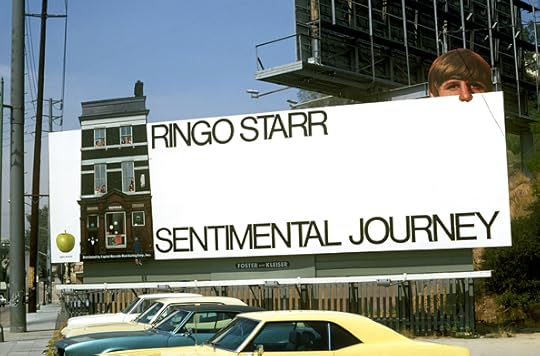
In L.A., music was who we were, what we did, and it manifested itself at Tower Records, at the Roxy and the Whiskey, and through Bill's Signs, which was the working title for Jay and the Americans. My father was the Leonardo of the Sunset Strip.
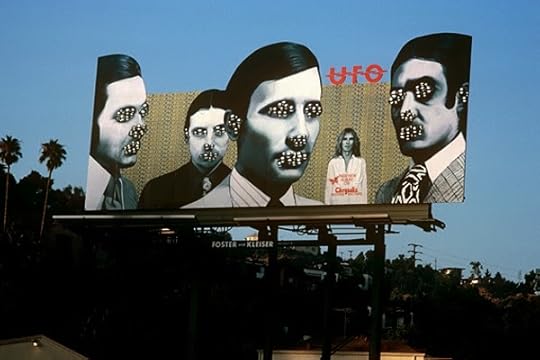 In 2012, probably without knowing him (my father's fame was anonymous), Robert Landau published what for him took a lifetime, a virtual retrospective of Bill's Signs, Rock 'n' Roll Billboards of the Sunset Strip, a beautiful coffee table book published by Angel City Press (available on Amazon and at Barnes and Nobel). Landau stated, "I was a kid and a music fan, I was buying those records, but my sensibility was more visual. I was drawn to the billboards because they were so non-commercial. A lot of them didn't even have text on them. It was like having an art gallery in my back yard."
In 2012, probably without knowing him (my father's fame was anonymous), Robert Landau published what for him took a lifetime, a virtual retrospective of Bill's Signs, Rock 'n' Roll Billboards of the Sunset Strip, a beautiful coffee table book published by Angel City Press (available on Amazon and at Barnes and Nobel). Landau stated, "I was a kid and a music fan, I was buying those records, but my sensibility was more visual. I was drawn to the billboards because they were so non-commercial. A lot of them didn't even have text on them. It was like having an art gallery in my back yard." 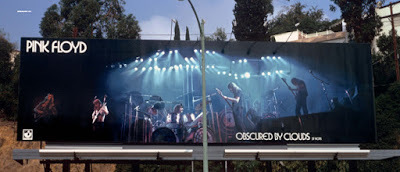 "The first one I shot was in 1969, for one of my favorite albums—the Beatles' Abbey Road. But in my research for the book, I talked to Jac Holzman, the founder of Electra Records, and he told me the first billboard that went up was for the Doors in 1967. They'd be up for a month, and then they'd all be painted over and a new one would go up," said Landau. That was my father's first billboard.
"The first one I shot was in 1969, for one of my favorite albums—the Beatles' Abbey Road. But in my research for the book, I talked to Jac Holzman, the founder of Electra Records, and he told me the first billboard that went up was for the Doors in 1967. They'd be up for a month, and then they'd all be painted over and a new one would go up," said Landau. That was my father's first billboard. Because of my father and those billboards, I grew up a writer and a music critic, but I never once asked him about his work or if he realized the impact of those billboards. He retired from Foster and Kleiser in the early 1980s and opened an art gallery in Jerome, Arizona, a "ghost town" in the desert between Prescott and Sedona. That was what he was proud of. The billboards were just life, a job, how he was able to mail out his child support checks and pay for his prized red Barracuda. To me, he really was Leonardo, on a grand scale.
Jay and the Americans (like Miles from Nowhere), is available all over the world!
Get your copy today!
CreateSpace - Amazon - Amazon UK - Amazon France - Amazon Russia

Published on October 05, 2019 23:17
Repost - Chuck E.'s in Love (AM10)
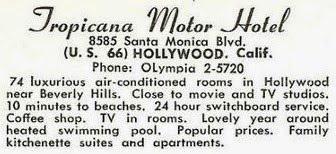
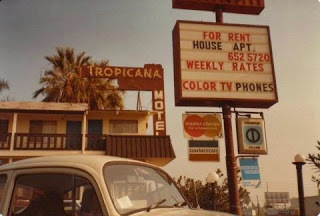 The Hollywood threesome that captured our attention in the late 70s was Tom Waits, Rickie Lee Jones and Chuck E. Weiss, who essentially became the most famous of the three, an accidental celebrity. In 1977, $65 bought a week at the seedy hipster paradise called the Tropicana on Santa Monica Blvd., just up the street from Barney's Beanery. Chuck E. slept on a couch, I suppose, or in the other bed. It's an assumption on my part, but as a compatriot hit up for quarters for the cigarette machine at the Troubadour on a regular basis, I can assume that he didn't have 65 bucks a week. "Chuck E.'s in Love" wouldn't be released for several more years, but the content of what may be the all time hippest single in pop history was already established. Waits, on the breadth of his first four LPs, but particularly on the success of Small Change, was already an established singer/songwriter, playing gigs at the Troub and at McCabe's in Santa Monica.
The Hollywood threesome that captured our attention in the late 70s was Tom Waits, Rickie Lee Jones and Chuck E. Weiss, who essentially became the most famous of the three, an accidental celebrity. In 1977, $65 bought a week at the seedy hipster paradise called the Tropicana on Santa Monica Blvd., just up the street from Barney's Beanery. Chuck E. slept on a couch, I suppose, or in the other bed. It's an assumption on my part, but as a compatriot hit up for quarters for the cigarette machine at the Troubadour on a regular basis, I can assume that he didn't have 65 bucks a week. "Chuck E.'s in Love" wouldn't be released for several more years, but the content of what may be the all time hippest single in pop history was already established. Waits, on the breadth of his first four LPs, but particularly on the success of Small Change, was already an established singer/songwriter, playing gigs at the Troub and at McCabe's in Santa Monica.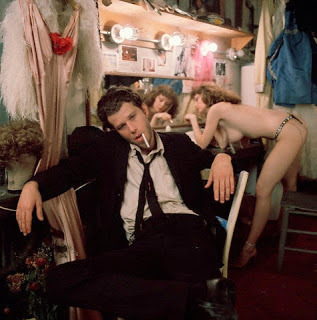 Let's Rewind. Waits' previous album, Nighthawks at the Diner (1975), was recorded at the Record Plant studio with an audience to capture the ambiance of a live venue. It was a pretty telling album. Of it he said, "I was sick through that whole period. I'd been traveling quite a bit, living in hotels, eating bad food, drinking a lot — too much. There's a lifestyle that's there before you arrive and you're introduced to it. It's unavoidable."
Let's Rewind. Waits' previous album, Nighthawks at the Diner (1975), was recorded at the Record Plant studio with an audience to capture the ambiance of a live venue. It was a pretty telling album. Of it he said, "I was sick through that whole period. I'd been traveling quite a bit, living in hotels, eating bad food, drinking a lot — too much. There's a lifestyle that's there before you arrive and you're introduced to it. It's unavoidable." Small Change (1976) found Waits in a cynical and pessimistic mood, with songs like "The Piano Has Been Drinking (Not Me) (An Evening with Pete King)" and "Bad Liver and a Broken Heart (In Lowell)." These were the songs that established Waits as a rock icon (including, of course, "Tom Traubert's Blues"). With Small Change Waits became a poster child, a poet laureate for off-kilter American cool and took his act overseas. Rickie Lee wasn't yet a part of his life.
That would change one fateful night at Doug Weston's Troubadour. Rickie Lee sang a short set of songs (including "The Moon is Made of Gold," only recently recorded for the album Balm in Gilead) following the performance of an obscure singer-songwriter named Ivan Ulz, who was instrumental in introducing several members of The Byrds, but little else. That night led to Tom's room at the Trop and a lifelong friendship of collaboration (if only temporary intimacy). Rickie never left and somewhere along the line, Chuck E. showed up.
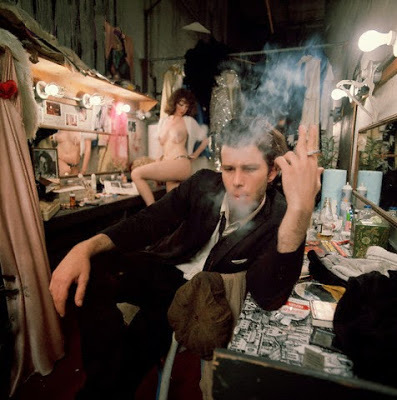 Then suddenly Chuck was gone, vanished. I went to the Troubadour and no one hit me up for a drink or for change. Every once in a while somebody'd say, "What happen to that guy?"
Then suddenly Chuck was gone, vanished. I went to the Troubadour and no one hit me up for a drink or for change. Every once in a while somebody'd say, "What happen to that guy?""Chuck E? I dunno."
Story goes that Chuck E. finally called Waits from Denver where he'd fallen in love with his cousin. When Waits got off the phone he said to Rickie, "Chuck E.'s in Love." Instrumental in the success of the Viper Room, just down from the Whiskey, Chuck E. Weiss's career as a singer/songwriter has never equaled his fame as that character in Rickie's story, the ending of which is fictional; there was never any relationship between the two. Chuck E. was "never in love with the little girl singin' this song."
Jay and the Americans is available all over the world!
Get Your Copy Today.
CreateSpace - Amazon - Amazon UK - Amazon France - Amazon Russia
Published on October 05, 2019 13:49



